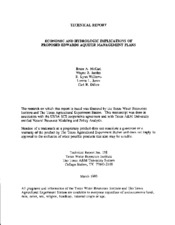| dc.description.abstract | The Edwards Aquifer underlies a large region in south central Texas extending from west of Uvalde to Austin. The karstic aquifer supports irrigated agriculture in the western part of the region, provides the sole source of water supply for San Antonio in the central portion and provides for spring flow-based recreation and municipal water supply in the eastern part of the region. In addition, spring flows and return flows from cities provide water supplies for downstream users and freshwater inflows to maintain productivity of bays and estuaries. The spring flows also support several threatened and endangered species unique to that ecosystem.
Despite the varied and growing demand on Edwards Aquifer water, pumpage is unregulated since, according to Texas water law, ground water is a property right vested with the land owner. Throughout at least the past two decades, attempts to negotiate voluntary management plans to restrict pumpage have been unsuccessful, even though demand is projected to exceed average recharge near the turn of the century.
A recent court ruling has increased the pressure for adoption of an Aquifer management plan. Acting on a suit brought to ensure spring flow and aquatic habitat protection under the Endangered Species Act, the court ruled that a management plan be developed and approved by the Texas Legislature by May 31, 1993. Should the Legislature fail, the court would implement its own plan.
In 1992, two management plans were drafted by the Texas Water Commission (TWC) but were not adopted. Since Texas Legislature is considering plans similar to the TWC plans, a study was undertaken to evaluate the hydrologic and economic implications of these TWC plans. Both plans propose imposition of pumping limits based on water elevation in a reference well located in San Antonio. Four variants of the plans were analyzed using an annual economic/hydrologic simulation model of the aquifer. The model simulates water use by the agricultural, industrial and municipal sectors while simultaneously forecasting annual spring flow and year-end water elevations. Model solutions depict optimum water allocations among sectors based on economic welfare maximization. The model also accounts for uncertainty in the incidence of elevation-triggered pumping limits and recharge amounts. When the value of water is optimized in an economic sense, the model predicts an annual loss in regional economic activity of between $6.26 and $19.58 per acre foot that pumpage is reduced.
Under a 1988 demand scenario, annual welfare is reduced between $0.73 and $1.57 million across the plans. The annual loss rises to between $2.38 and $6.60 million under estimated year 2000 demand conditions. Agricultural water use is the most pivotal: under year 2000 demands, irrigated acres decline by 32% to 84% while net agricultural income falls annually by $1 million (13%) to $2.5 million (36%). Simultaneously, the municipal and industrial sector welfare is reduced annually by between $0.8 million (2%) and $5.7 million (8%).
The benefits from all management plans are increased spring flows at Comal and San Marcos springs and higher ending aquifer levels. However, none of the proposed plans is forecast to guarantee flows at Comal springs given a repeat of the 1950's drought.
The model assumes that low valued users would allow higher valued users to displace their water use, a result that is unlikely in the absence of compensation. Thus, a rights structure was also examined where the irrigated agriculture sector (generally a low valued user) is guaranteed water usage at the 1988 level. The results demonstrate that while agricultural welfare is raised, municipal, industrial and total welfare is reduced by more than the agricultural gain. In other words, agricultural gains are achieved at the expense of municipal and industrial welfare. Equivalently, without an agricultural guarantee, the municipal and industrial gains are achieved at agriculture's expense. One set of results reveals a year 2000 agricultural use value equals about $19 per acre foot while non- agricultural values are about $109 per acre foot.
The results suggest the desirability of simultaneously implementing water market mechanisms to allow water use reallocation along with plan-induced pumpage restrictions. An unchanging allocation of pumping use causes growing disparity in sectoral water values as demand grows ($90 per acre foot in the above example). The simultaneous imposition of pumpage limits, water rights and water markets appears necessary to maintain economic efficiency. The results show that allowing water sales through a market mechanism could return as much as $11 million annually, while allowing both water sales and leasing is worth an additional $1 million. Markets would allow economic agents to seek out the highest valued uses of scarce aquifer water resources and provide compensation to those users reducing their usage. | en |


